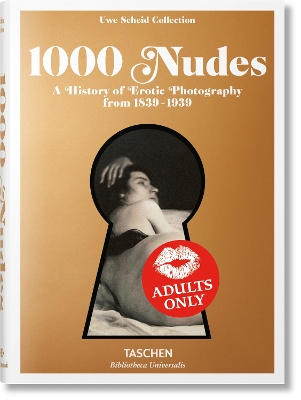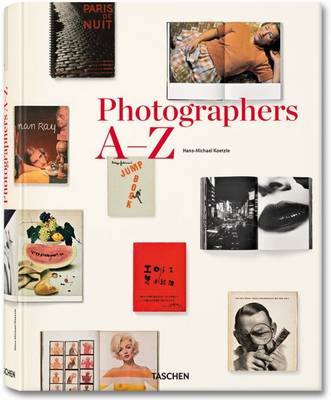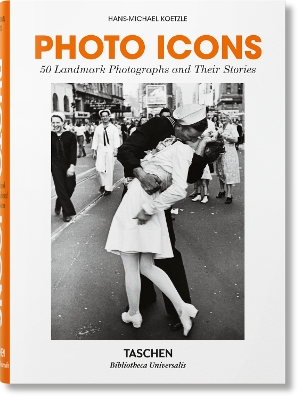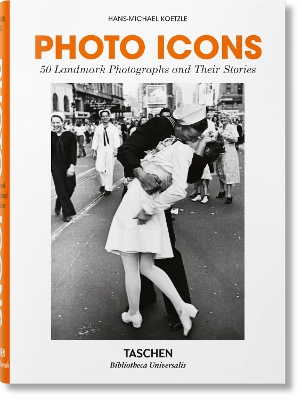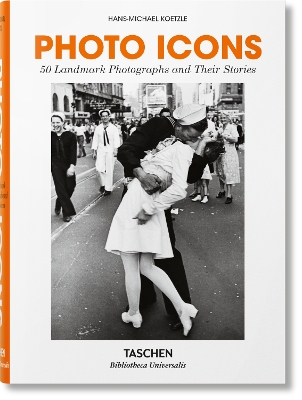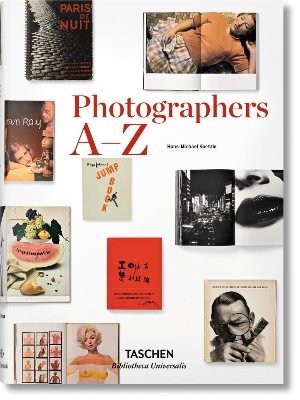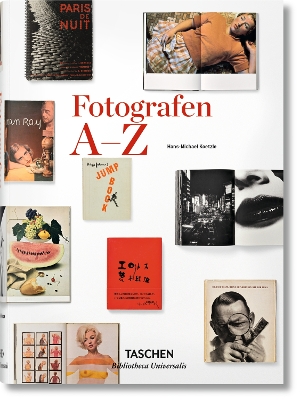Bibliotheca Universalis
8 total works
1000 Nudes. A History of Erotic Photography from 1839-1939
by Hans-Michael Koetzle and Uwe Scheid
The history of nude photography is the history of people’s fascination with the topic. Indeed, the photographic depiction of the human body is the only subject that has enthralled photographers, theoreticians, and consumers over such a long period—more than 150 years. No other motif is as prevalent as this one during all the phases of development comprising the history of photography, no other is present, whatever the technique, and is a subject of discussion within the context of nearly all aesthetic movements. Nor has any other pictorial topic produced such a variety of specialities as the nude: from the ethnological interpretation of the body to the glamour shot, from nudist photography to the pin-up of today. No other photographic field of application has inspired as much desire as it has awakened official wrath.
1000 Nudes offers a cross section of the history of nude photography, ranging from the earliest nude daguerreotypes and ethnographic nude photographs to experimental nude photography. The period of time spanned by this work is from 1839 to roughly 1939, from the medium’s infancy to the end of the classic modernist period. Content-wise, the book pays tribute to the full range of pictorial approaches, from the manually elaborated artistic nudes of the turn of the century, enveloped in layers of theory, to the “obscene” postcard motifs which had not the slightest artistic pretension and were intended to exert a maximum effect on the buyer’s wallet.
All the pictures shown are taken from the late Uwe Scheid’s collection, one of the world’s largest and most important collections of erotic photography.
"Photographers A-Z" focuses on photographic images and culture, but also features photographers working in 'applied' areas, whose work goes beyond the merely illustrative, and is regarded as photographic art or is conserved by major museums, such as Julius Shulman, Terry Richardson, Cindy Sherman, and David LaChapelle, etc.
Featured photographers include: Ansel Adams, Manuel Alvarez-Bravo, Nobuyoshi Araki, Diane Arbus, Richard Avedon, David Bailey, Elmer Batters, Peter Beard, Cecil Beaton, Werner Bischof, Guy Bourdin, Bill Brandt, Robert Capa, William Claxton, Anton Corbijn, Robert Doisneau, William Eggleston, Masahisa Fukase, Ron Galella, Nan Goldin, Jean-Paul Goude, John Heartfield, Eikoh Hosoe, George Hoyningen-Huene, Seydou Keita, William Klein, Nick Knight, Neil Leifer, Peter Lindbergh, Man Ray, Robert Mapplethorpe, Inez van Lamsweerde & Vinoodh Matadin, Jean-Baptiste Mondino, Helmut Newton, Martin Parr, Irving Penn, Pierre et Gilles, Bettina Rheims, Leni Riefenstahl, Sebastiao Salgado, Andres Serrano, Cindy Sherman, Kishin Shinoyama, Jeanloup Sieff, Lord Snowdon, Bert Stern, Larry Sultan, Mario Testino, Wolfgang Tillmans, Ellen von Unwerth, Andy Warhol, Bruce Weber, Weegee, Gary Winogrand and many more.
Photo Icons. 50 photographies emblématiques et leur histoire
by Hans-Michael Koetzle
Photographs have a strange and powerful way of shaping the way we see the world. The most successful images enter our collective consciousness, defining eras, making history, or simply touching something so fundamentally human and universal that they have become resonant icons all over the globe. To explore this unique influence, Photo Icons puts some of the most important photographic landmarks under the microscope.
From some of the earliest photography, such as Nicéphore Niépce’s 1827 eight-hour-exposure rooftop picture and Louis Daguerre’s famous 1838 street scene, through to Martin Parr, this is as much a history of the medium as a case-by-case analysis of its social, historical, and artistic impact. We take in experimental Surrealist shots of the 1920s and the gritty photorealism of the 1930s, including Dorothea Lange’s Migrant Mother.
We witness the power-makers (Che Guevara) and the heartbreakers (Marilyn Monroe) as well as the great gamut of human emotions and experiences to which photography bears such vivid witness: from the euphoric Kiss in Front of City Hall (1950) by Doisneau to the horror of Nick Ut’s Napalm Against Civilians showing nine-year-old Phan Thi Kim Phúc running naked toward the camera from South Vietnamese napalm.
Photo Icons. 50 Landmark Photographs and Their Stories
by Hans-Michael Koetzle
Photographs have a strange and powerful way of shaping the way we see the world. The most successful images enter our collective consciousness, defining eras, making history, or simply touching something so fundamentally human and universal that they have become resonant icons all over the globe. To explore this unique influence, Photo Icons puts some of the most important photographic landmarks under the microscope.
From some of the earliest photography, such as Nicéphore Niépce’s 1827 eight-hour-exposure rooftop picture and Louis Daguerre’s famous 1838 street scene, through to Martin Parr, this is as much a history of the medium as a case-by-case analysis of its social, historical, and artistic impact. We take in experimental Surrealist shots of the 1920s and the gritty photorealism of the 1930s, including Dorothea Lange’s Migrant Mother.
We witness the power-makers (Che Guevara) and the heartbreakers (Marilyn Monroe) as well as the great gamut of human emotions and experiences to which photography bears such vivid witness: from the euphoric Kiss in Front of City Hall (1950) by Doisneau to the horror of Nick Ut’s Napalm Against Civilians showing nine-year-old Phan Thi Kim Phúc running naked toward the camera from South Vietnamese napalm.
Fotografías míticas. 50 fotografías emblemáticas y su historia
by Hans-Michael Koetzle
Photographs have a strange and powerful way of shaping the way we see the world. The most successful images enter our collective consciousness, defining eras, making history, or simply touching something so fundamentally human and universal that they have become resonant icons all over the globe. To explore this unique influence, Photo Icons puts some of the most important photographic landmarks under the microscope.
From some of the earliest photography, such as Nicéphore Niépce’s 1827 eight-hour-exposure rooftop picture and Louis Daguerre’s famous 1838 street scene, through to Martin Parr, this is as much a history of the medium as a case-by-case analysis of its social, historical, and artistic impact. We take in experimental Surrealist shots of the 1920s and the gritty photorealism of the 1930s, including Dorothea Lange’s Migrant Mother.
We witness the power-makers (Che Guevara) and the heartbreakers (Marilyn Monroe) as well as the great gamut of human emotions and experiences to which photography bears such vivid witness: from the euphoric Kiss in Front of City Hall (1950) by Doisneau to the horror of Nick Ut’s Napalm Against Civilians showing nine-year-old Phan Thi Kim Phúc running naked toward the camera from South Vietnamese napalm.
Arranged alphabetically, this biographical encyclopedia features every major photographer of the 20th century alongside her or his most significant monographs.
From the earliest representatives of classical Modernism right up to the present day, Photographers A–Z celebrates those photographers who have distinguished themselves with important publications or exhibitions, and who have made a significant contribution to the culture of the photographic image. The entries include photographers from North America and Europe as well as from Japan, Latin America, Africa, and China.
Richly illustrated with facsimiles from books and magazines, the collection also features photographers working in “applied” areas, whose work is regarded as photographic art. Star turns include Julius Shulman, Terry Richardson, Cindy Sherman, and David LaChapelle.
Arranged alphabetically, this biographical encyclopedia features every major photographer of the 20th century alongside her or his most significant monographs.
From the earliest representatives of classical Modernism right up to the present day, Photographers A–Z celebrates those photographers who have distinguished themselves with important publications or exhibitions, and who have made a significant contribution to the culture of the photographic image. The entries include photographers from North America and Europe as well as from Japan, Latin America, Africa, and China.
Richly illustrated with facsimiles from books and magazines, the collection also features photographers working in “applied” areas, whose work is regarded as photographic art. Star turns include Julius Shulman, Terry Richardson, Cindy Sherman, and David LaChapelle.
Arranged alphabetically, this biographical encyclopedia features every major photographer of the 20th century alongside her or his most significant monographs.
From the earliest representatives of classical Modernism right up to the present day, Photographers A–Z celebrates those photographers who have distinguished themselves with important publications or exhibitions, and who have made a significant contribution to the culture of the photographic image. The entries include photographers from North America and Europe as well as from Japan, Latin America, Africa, and China.
Richly illustrated with facsimiles from books and magazines, the collection also features photographers working in “applied” areas, whose work is regarded as photographic art. Star turns include Julius Shulman, Terry Richardson, Cindy Sherman, and David LaChapelle.
